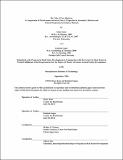| dc.contributor.advisor | Walter N. Torous. | en_US |
| dc.contributor.author | Katz, Omer, S.M. Massachusetts Institute of Technology | en_US |
| dc.contributor.author | Gupta,Kailash | en_US |
| dc.contributor.other | Massachusetts Institute of Technology. Center for Real Estate. Program in Real Estate Development. | en_US |
| dc.date.accessioned | 2015-01-05T19:35:38Z | |
| dc.date.available | 2015-01-05T19:35:38Z | |
| dc.date.copyright | 2014 | en_US |
| dc.date.issued | 2014 | en_US |
| dc.identifier.uri | http://hdl.handle.net/1721.1/92606 | |
| dc.description | Thesis: S.M. in Real Estate Development, Massachusetts Institute of Technology, Program in Real Estate Development in conjunction with the Center for Real Estate, 2014. | en_US |
| dc.description | This electronic version was submitted by the student author. The certified thesis is available in the Institute Archives and Special Collections. | en_US |
| dc.description | Cataloged from student-submitted PDF version of thesis. | en_US |
| dc.description | Includes bibliographical references (page 65). | en_US |
| dc.description.abstract | As the number of investors in real estate expands and current investors increase their target allocations, we can expect to see a substantial increase in the investment pace in real estate for institutions. Investors seeking high yields have been shifting their focus away from core investments due to high prices and resulting low yields, and have started to look beyond core properties and core markets for opportunities. This thesis examines the historical performance of Class A buildings in secondary markets and Class B buildings in primary markets from 2005 to 2013. Historical performance data is used from NCREIF, and the CoStar database is used to classify each property as Class A or Class B. Through this study we hope to shed some light on the importance of location and asset type (Class A or Class B buildings) as determinants of returns in commercial real estate investments. An analysis of our empirical findings, on an aggregated basis of an entire real estate cycle (2005-2013), indicates that while office and multifamily properties have demonstrated similar behavior throughout the cycle, this has not been the case for industrial properties. In the case of office and multifamily properties, Class B buildings in primary markets have outperformed Class A properties in secondary markets and the NCREIF NPI. As opposed to these distinct results, in the case of industrial properties, Class A buildings in secondary markets have outperformed Class B properties in primary markets and the NCREIF NPI. One explanation for this unpredictable behavior might be associated with the substantial economic and physical differences of industrial properties, specifically when compared to office and multifamily properties. Another possible explanation of this result has to do with the relatively small size of NCREIF data on industrial properties, and, consequentially, the industrial property data in this thesis was comprised of merely 93 industrial properties. Based on the overall empirical findings of our study, a savvy real estate investor, who is dedicated to maximizing his long run returns, would be better off investing in office and multifamily properties in primary markets, and in industrial properties in secondary markets. | en_US |
| dc.description.statementofresponsibility | by Omer Katz and Kailash Gupta. | en_US |
| dc.format.extent | 65 pages | en_US |
| dc.language.iso | eng | en_US |
| dc.publisher | Massachusetts Institute of Technology | en_US |
| dc.rights | M.I.T. theses are protected by copyright. They may be viewed from this source for any purpose, but reproduction or distribution in any format is prohibited without written permission. See provided URL for inquiries about permission. | en_US |
| dc.rights.uri | http://dspace.mit.edu/handle/1721.1/7582 | en_US |
| dc.subject | Center for Real Estate. Program in Real Estate Development. | en_US |
| dc.title | The tale of two markets : a comparison of performance between Class A properties in secondary markets and Class B properties in primary markets | en_US |
| dc.title.alternative | Comparison of performance between Class A properties in secondary markets and Class B properties in primary markets | en_US |
| dc.type | Thesis | en_US |
| dc.description.degree | S.M. in Real Estate Development | en_US |
| dc.contributor.department | Massachusetts Institute of Technology. Center for Real Estate. Program in Real Estate Development. | en_US |
| dc.contributor.department | Massachusetts Institute of Technology. Center for Real Estate | |
| dc.identifier.oclc | 898189339 | en_US |
